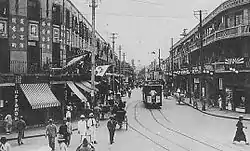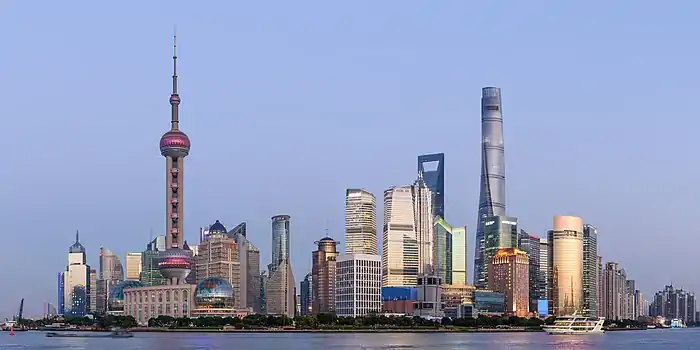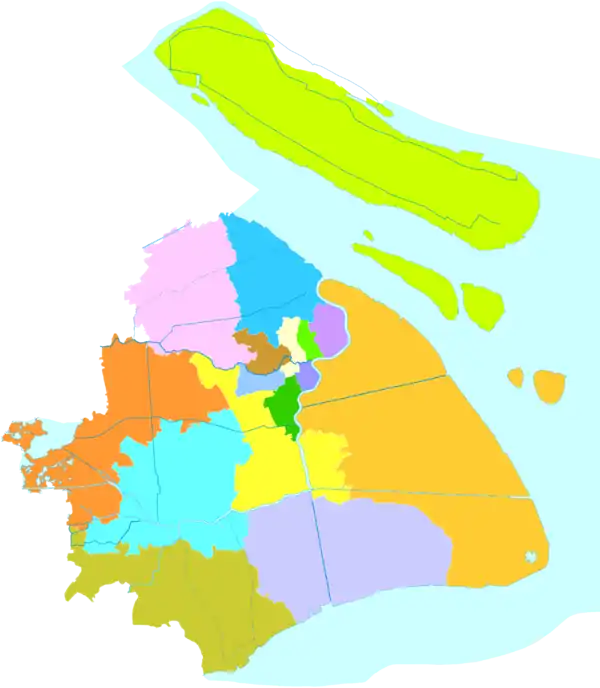Shanghai International Settlement
The Shanghai International Settlement (Chinese: 上海公共租界) originated from the merger in the year 1863 of the British and American enclaves in Shanghai, in which British subjects and American citizens would enjoy extraterritorially and consular jurisdiction under the terms of Unequal Treaties signed in the nineteenth century with the Qing Dynasty. These treaties were abrogated in 1943 by agreement with the Kuomintang, then based in Chungking.
| Shanghai International Settlement 上海公共租界 | |||||||||||
|---|---|---|---|---|---|---|---|---|---|---|---|
| International Settlement | |||||||||||
| 1863–1941 | |||||||||||
 Flag of the Shanghai Municipality
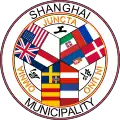 Seal of the Shanghai Municipality
| |||||||||||
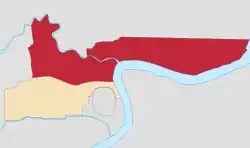 Location of Shanghai International Settlement (in red) relative to the French Concession (faded yellow) and the Chinese zone (grey) | |||||||||||
| Demonym | Shanghailander | ||||||||||
| Area | |||||||||||
• 1925 | 22.59 km2 (8.72 sq mi) | ||||||||||
| Population | |||||||||||
• 1910 | 501,561 | ||||||||||
• 1925 | 1,137,298 | ||||||||||
| Government | |||||||||||
| • Motto | Omnia Juncta in Uno (Latin) "All Joined into One" | ||||||||||
| History | |||||||||||
• Established | 1863 | ||||||||||
• Disestablished | 1941 | ||||||||||
| |||||||||||
| Today part of | |||||||||||
_1.JPG.webp)
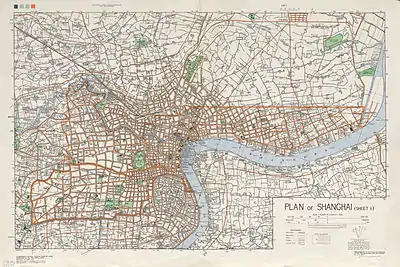
| Shanghai International Settlement | |||||||||||||
|---|---|---|---|---|---|---|---|---|---|---|---|---|---|
| Chinese | 上海公共租界 | ||||||||||||
| Literal meaning | Shanghai communal concession territories | ||||||||||||
| |||||||||||||
The settlements were established following the defeat of the Qing army by the British in the First Opium War (1839–1842). Under the terms of the Treaty of Nanking, the five treaty ports including Shanghai were opened to foreign merchants, overturning the monopoly then held by the southern port of Canton (Guangzhou) under the Canton System. The British also established a base on Hong Kong. American and French involvement followed closely on the heels of the British and their enclaves were established north and south, respectively, of the British area.
Unlike the colonies of Hong Kong and Macau, where the United Kingdom and Portugal enjoyed full sovereignty in perpetuity, the foreign concessions in China remained under Chinese sovereignty. In 1854, the three countries created the Shanghai Municipal Council to serve all their interests, but, in 1862, the French concession dropped out of the arrangement. The following year the British and American settlements formally united to create the Shanghai International Settlement. As more foreign powers entered into treaty relations with China, their nationals also became part of the administration of the settlement, but it always remained a predominantly British affair until the growth of Japan's involvement in the late 1930s. The international character of the Settlement was reflected in the flag and seal of the Municipal Council, which featured the flags of several countries.[note 1]
The international settlement came to an abrupt end in December 1941 when Japanese troops stormed in immediately following the attack on Pearl Harbor. In early 1943, new treaties signed by Chiang Kai-shek's Republican government formally ended the extraterritorial privileges of Americans and Britons, although its terms were moot until the recovery of Shanghai following Japan's 1945 surrender. The French later surrendered their privileges in a separate agreement in February 1946.
History
Arrival of the Americans, British and other Europeans
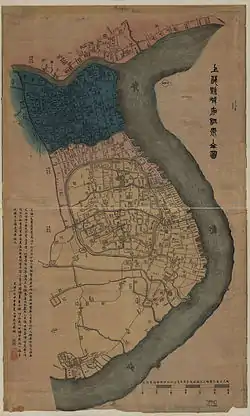
Although Europeans had shown more interest in Canton than Shanghai early on for commercial advantages, the port's strategic position was key to British interests as the island nation declared war against China in 1839, starting the first Anglo-Chinese Opium War. The first settlement in Shanghai for foreigners was the British settlement, opened in 1843 under the terms of the Treaty of Nanking.[1] This treaty forced the Qing Dynasty to make punitive territorial and economic concessions and would become the first of the unequal treaties imposed upon China by its fellow great powers.[2] To the north, the settlement was bordered by the right bank of the Suzhou River before its inflow into the Huangpu River, which delineated the concession's eastern boundaries. To the south, the Yang-King-Pang channel marked the concession's southern limits which would later become the boundary between the British and French concessions.
On the orders of Sir Henry Pottinger, first Governor of Hong Kong, Captain George Balfour of the East India Company's Madras Artillery arrived as Britain's first consul in Shanghai on 8 November 1843 aboard the steamer Medusa.[3] The next morning Balfour sent word to the circuit intendant of Shanghai, Gong Mujiu (then romanized Kung Moo-yun), requesting a meeting, at which he indicated his desire to find a house to live in. Initially Balfour was told no such properties were available, but on leaving the meeting, he received an offer from a pro-British Cantonese named Yao to rent a large house within the city walls for four hundred dollars per annum. Balfour, his interpreter Walter Henry Medhurst, surgeon Dr. Hale and clerk A. F. Strachan moved into the luxuriously furnished 52-room house immediately.[4]
It served as the consulate during construction of a Western-style building within the official Settlement boundaries just to the south of Suzhou Creek. This was completed within a year. This soon became the epicenter of the British settlement. Afterward both the French and the Americans signed treaties with China that gave their citizens extraterritorial rights similar to those granted to the British, but initially their respective nationals accepted that the foreign settlement came under British consular jurisdiction. However, it must be clearly understood that Shanghai has been from the beginning a settlement, not a possession. The British Government annexed Hong Kong, which became British territory, and subject to British law. The land on which the Foreign Settlement of Shanghai was created was, on the other hand, only leased to the British Government. That is proved by the fact that all the landowners still pay ground rent to the Chinese Government.[1]
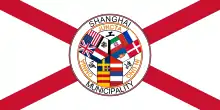
The Sino-American Treaty of Wanghia was signed in July 1844 by Chinese Qing government official Qiying, the Viceroy of Liangguang, who held responsibility for the provinces of Guangdong and Guangxi, and Massachusetts politician Caleb Cushing (1800–1879), who was dispatched with orders to "save the Chinese from the condition of being an exclusive monopoly in the hands of England" as a consequence of the 1842 Nanking treaty. Under the Treaty of Wanghia, Americans gained the same rights as those enjoyed by the British in China's treaty ports. It also contained a clause that effectively carved out Shanghai as an extraterritorial zone within Imperial China, though it did not actually give the American government a true legal concession.[5]
It was only in 1845 that Britain followed in America's footsteps and signed a land-deal to allow Britons to rent land in Shanghai in perpetuity. The American consular presence did not create a problem for the British because it was never intended to have a post in person. Since American traders in China were prohibited from engaging in the opium trade, their business transactions were conducted under the auspices of British firms. The only serious incident of political complaint against the Americans was in 1845, when the Stars and Stripes was raised by the acting US Consul, Henry G. Wolcott, who had just arrived in the city. Neither the British nor the Chinese governor approved of the display. In 1848, France established its own French concession under French consular jurisdiction, squeezed between the British settlement to the north and the Chinese walled city to the south.
During the Taiping Rebellion, with the Concessions effectively landlocked by both the Manchu government and Small Swords Society rebels, the Western residents of the Shanghai International Settlement, known as "Shanghailanders", refused to pay taxes to the Chinese government except for land and maritime rates (nominally because Shanghai's customs house had been burnt down). They also claimed the right to exclude Chinese troops from the concession areas. While the Settlement had at first disallowed non-foreigners from living inside its boundaries, a large number of Chinese were allowed to move into the International Settlement to escape the Taipings or seek better economic opportunities. Chinese entry was subsequently legalised and continued to grow.
Municipal Council
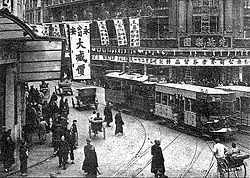
On 11 July 1854 a committee of Western businessmen met and held the first annual meeting of the Shanghai Municipal Council (SMC, formally the Council for the Foreign Settlement North of the Yang-king-pang), ignoring protests of consular officials, and laid down the Land Regulations which established the principles of self-government. The aims of this first Council were simply to assist in the formation of roads, refuse collection, and taxation across the disparate Concessions.
In 1863 the American concession—land fronting the Huangpu River to the north-east of Soochow Creek (Suzhou Creek)—officially joined the British Settlement (stretching from Yang-ching-pang Creek to Suzhou Creek) to become the Shanghai International Settlement. The French concession remained independent and the Chinese retained control over the original walled city and the area surrounding the foreign enclaves. This would later result in sometimes absurd administrative outcomes, such as needing three drivers' licenses to travel through the complete city.
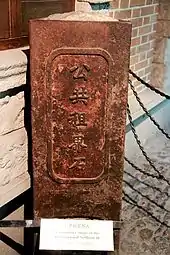
By the late-1860s Shanghai's official governing body had been practically transferred from the individual concessions to the Shanghai Municipal Council (工部局, literally "Works Department", from the standard English local government title of 'Board of works'). The British Consul was the de jure authority in the Settlement, but he had no actual power unless the ratepayers (who voted for the Council) agreed. Instead, he and the other consulates deferred to the Council.
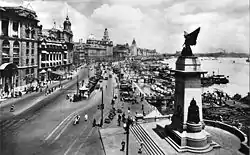
The Council had become a practical monopoly over the city's businesses by the mid-1880s. It bought up all the local gas-suppliers, electricity producers and water-companies, then — during the 20th-century — took control over all non-private rickshaws and the Settlement tramways. It also regulated opium sales and prostitution until their banning in 1918 and 1920 respectively.
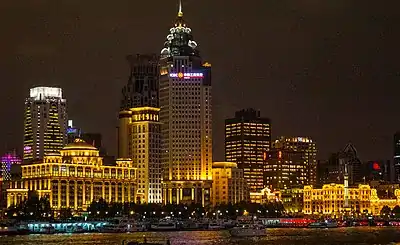
Until the late-1920s, therefore, the SMC and its subsidiaries, including the police, power station, and public works, were British dominated (though not controlled, since Britain itself had no authority over the Council). Some of the Settlement's actions during this period, such as the May 30th Movement, in which Chinese demonstrators were shot by members of the Shanghai Municipal Police, did embarrass and threaten the British Empire's position in China even though they were not carried out by "Britain" itself.
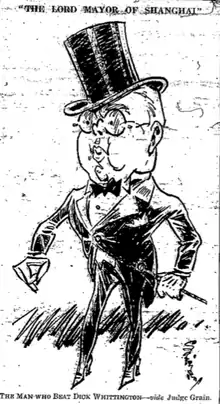
No Chinese residing in the International Settlement were permitted to join the council until 1928. Amongst the many members who served on the council, its chairman during the 1920s, Stirling Fessenden, is possibly the most notable. An American, he served as the settlement's main administrator during Shanghai's most turbulent era, and was considered more "British" than the council's British members. He oversaw many of the major incidents of the decade, including the May 30th Movement and the White Terror that came with the Shanghai massacre of 1927.
By the early 1930s, the British and the Chinese each had five members on the Council, the Japanese two and the Americans and others two.[6] At the 1936 Council election, because of their increasing interests in the Settlement, the Japanese nominated three candidates. Only two were elected, which led to a Japanese protest after 323 uncounted votes were discovered. As a result, the election was declared invalid and a new poll held on April 20-21, 1936, at which the Japanese nominated only two candidates.[7] In the case of the Chinese members, in 1926 the Ratepayers' Meeting adopted a resolution approving the addition of three Chinese members to the Council and they took their seats for the first time in April, 1928; while in May, 1930, their number was increased to five.[8]
The International Settlement was wholly foreign-controlled, with staff of all nationalities, including British, Americans, Danes, Italians and Germans. In reality, the British held the largest number of seats on the Council and headed all the Municipal departments (British included Australians, New Zealanders, Canadians, Newfoundlanders, and South Africans whose extraterritorial rights were established by the United Kingdom treaty).
The only department not chaired by a Briton was the Municipal Orchestra, which was controlled by an Italian.
The Settlement maintained its own fire-service, police force (the Shanghai Municipal Police), and even possessed its own military reserve in the Shanghai Volunteer Corps (萬國商團). Following some disturbances at the British concession in Hankow in 1927, the defences at Shanghai were augmented by a permanent battalion of the British Army, which was referred to as the Shanghai Defence Force (SDF or SHAF),[9] and a contingent of US Marines. Other armed forces would arrive in Shanghai; the French Concession had a defensive force of Troupes de marine and Annamite suppletive troops from French Indochina, the Italians also introduced their own marines, as did the Japanese (whose troops eventually outnumbered the other countries' many times over).
Extra-settlement roads
From the 1860s, the Municipal Council began building roads beyond the concession boundaries, ostensibly to connect the concession with other properties or facilities which required the protection of Britain and other treaty powers during the unrest of the Taiping Rebellion. The Municipal Council obtained limited administrative powers over the areas adjacent to these "extra-settlement roads", making the area a "quasi-concession". The expansion of the International Settlement in 1899 took in most of the extra-settlement roads area, but from 1901 the Municipal Council began building further roads beyond the new boundary with a view to expanding the concession to cover those areas as well. However, a request to further expand the concession (inspired by a similar expansion of the French concession in 1914) was turned down by the Chinese government due to anti-imperialist sentiments. Britain, pre-occupied with World War I, did not press the issue and the extra-settlement roads area retained the "quasi-concession" status until the demise of the concession. Parts of the northern extra-settlement roads area was allocated to Japan for defence purposes in 1927, which the Japanese used as a base for military operations during the 1932 January 28th Incident and the 1937 Battle of Shanghai. After that battle, Japan took full control over the northern extra-settlement roads area and expelled International Settlement police. The neutrality of the western extra-settlement roads area survived in some form until the withdrawal of British troops in 1940.
Legal Status of the International Settlement
Article 28 of the International Settlement's Land Regulations stated unequivocally that "the land encompassed in the territory remains Chinese territory, subject to China's sovereign rights." As expressed by legal experts, "the self-governing International Settlement possesses no more power than the mere delegation of purely local and municipal powers and functions. Control of police, sanitation, roads, and other problems of local administration are granted to the Municipal Council simply because that body happens to be the one best equipped to deal with these matters in an area where the large majority of foreigners dwell. But the Municipal Council is in no sense a political body. Its powers, being delegated and hence limited, are subject to strict construction. What foreigners acquire is simply the delegated power of municipal administration, while the reserve powers remain in the sovereign grantor, the Chinese Government. Although under the control of the Consular Council, the area is still Chinese territory, over which China's sovereignty remains unsurrendered".[10][11]
Rise of Imperial Japan (20th century)
In the 19th century, Europeans possessed treaty ports in Japan in the same way they held those in China. However, Japan rapidly developed into a modern nation, and by the turn of the 20th century the Japanese had successfully negotiated with all powers to abrogate all unequal treaties with it. Japan stood alongside the European powers as part of the Eight-Nation Alliance during the infamous fifty five-day siege of the foreign embassy compound in Peking. Japan entered the 20th century as a rising world power, and with its unequal treaties with the European powers now abrogated, it actually joined in, obtaining an unequal treaty with China granting extraterritorial rights under the Treaty of Shimonoseki signed in 1895.
In 1915, during the First World War, Japan overtook Britain as the country with the largest number of foreign residents in Shanghai. In 1914 they sided with Britain and France in the war and conquered all German possessions in China. By the beginning of the 1930s, Japan was swiftly becoming the most powerful national group in Shanghai and accounted for some 80% of all extraterritorial foreigners in China. Much of Hongkew, which had become an unofficial Japanese settlement, was known as Little Tokyo.
In 1931, supposed "protection of Japanese colonists from Chinese aggression" in Hongkew was used as a pretext for the Shanghai Incident, when Japanese troops invaded Shanghai. From then until the Second Sino-Japanese War (1937–1945) Hongkew was almost entirely outside of the SMC's hands, with law and protection enforced to varying degrees by the Japanese Consular Police and Japanese members of the Shanghai Municipal Police.
Japanese take over rest of Shanghai (1937)
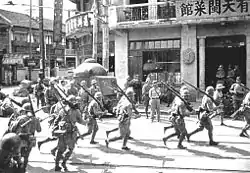
In 1932 there were 1,040,780 Chinese living within the International Settlement, with another 400,000 fleeing into the area after the Second Sino-Japanese War broke out in 1937. For the next five years, the International Settlement and the French Concession were surrounded by Japanese occupiers and Chinese revolutionaries, with conflict often spilling into the Settlement's borders. In 1941, the Japanese launched an abortive political bid to take over the SMC: during a mass meeting of ratepayers at the Settlement Race Grounds, a Japanese official leaped up and shot William Keswick, then Chairman of the Council. While Keswick was only wounded, a near riot broke out.[12]
Evacuation of British garrison
Britain evacuated its garrisons from mainland Chinese cities, particularly Shanghai, in August 1940.[13]:299

Japanese occupy the International Settlement (1941)
Anglo-American influence effectively ended after 8 December 1941, when the Imperial Japanese Army entered and occupied the British and American controlled parts of the city in the wake of the attack on Pearl Harbor. The British and Americans troops taken by surprise surrendered without a shot, with the exception of the only British riverboat in Shanghai, HMS Peterel, which refused to surrender: six of the 18 British crew who were on board at the time were killed when the ship was sunk when the Japanese opened fire at almost point-blank range.[14] The French troops did not move from the preserved French Concession, as the French Vichy government considered itself neutral.
European residents of the International Settlement were forced to wear armbands to differentiate them, were evicted from their homes, and — just like Chinese citizens — were liable to maltreatment. All were liable for punitive punishments, torture and even death during the period of Japanese occupation. The Japanese sent European and American citizens to be interned at the Lunghua Civilian Assembly Center, a work camp on what was then the outskirts of Shanghai. Survivors of Lunghua were released in August 1945.[15]
Shanghai was notable for a long period as the only place in the world that unconditionally offered refuge for Jews escaping from the Nazis.[16] These refugees often lived in squalid conditions in an area known as the Shanghai Ghetto in Hongkew. On 21 August 1941 the Japanese government closed Hongkew to Jewish immigration.[17]
Return to Chinese rule
In February 1943, the International Settlement was de jure returned to the Chinese as part of the British–Chinese Treaty for the Relinquishment of Extra-Territorial Rights in China and American–Chinese Treaty for Relinquishment of Extraterritorial Rights in China with the Nationalist Government of the Republic of China under Chiang Kai-shek. However, because Shanghai was under Japanese control, this was unenforceable. In reply, in July 1943, the Japanese retroceded the SMC to the City Government of Shanghai, which was then in the hands of the pro-Japanese Wang Jingwei Government.
After the war and the liberation of the city from the Japanese, a Liquidation Commission fitfully met to discuss the remaining details of the handover. By the end of 1945, most westerners not actively involved in the Chinese Civil War (such as intelligence agents, soldiers, journalists etc.) or in Shanghai's remaining foreign businesses, had left the city. With the defeat of the Kuomintang in 1949, the city was occupied by Communist PLA and came under the control of Mayor of Shanghai.
The foreign architecture of the International Settlement era can still be seen today along the Bund and in many locations around the city.
Legal system

The International Settlement did not have a unified legal system. The Municipal Council issued Land Regulations and regulations under this, that were binding on all people in the settlement. Other than this, citizens and subjects of powers that had treaties with China that provided for extraterritorial rights were subject to the laws of their own countries and civil and criminal complaints against them were required to be brought against them to their consular courts (courts overseen by consular officials) under the laws of their own countries.[18]
The number of treaty powers had climbed to a maximum of 19 by 1918 but was down to 14 by the 1930s: the United Kingdom, the United States, Japan, France, Italy, Norway, Sweden, Denmark, the Netherlands, Spain, Portugal, Peru, Mexico, and Switzerland. Germany and Austria-Hungary lost their treaty rights after WWI, and Russia gave up her rights as a matter of political expediency. Belgium was declared by China to have lost her rights in 1927.[19] Furthermore, the Chinese government adamantly refused to grant treaty power status to any of the new nations born in the wake of WWI, such as Austria and Hungary (formerly Austria-Hungary), Poland, Czechoslovakia, Yugoslavia, the Baltic States and Finland.
Chinese citizens and citizens of non-treaty powers were subject to Chinese law. Inside the Settlement, cases against them would be brought to the Mixed Court, a court established in the Settlement in the 1864 which existed until 1926. In cases involving foreigners, a foreign assessor, usually a consular officer, would sit with the Chinese magistrate and in many cases acted like a judge. In 1927, a Provisional Court was established with a sole Chinese judge presiding. In 1930, Chinese Special Courts were established which had jurisdiction over all non treaty power individuals and companies in the Settlement.
Two countries, Britain and the United States established formal court systems in China to try cases. The British Supreme Court for China and Japan was established in 1865 and located in its own building in the British Consulate compound and the United States Court for China was established in the US Consulate in 1906. Both courts were occupied by the Japanese on 8 December 1941 and effectively ceased to function from that date.
Currency
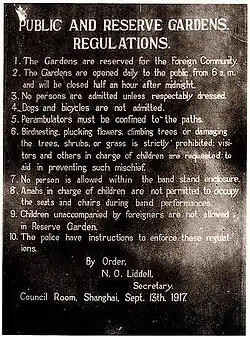
The currency situation in China generally was very complicated in the 19th century. There was no unified system. Different parts of China operated different systems, and the Spanish pieces of eight that had been coming from Mexico for a few hundred years on Manila Galleons were current along the China coast. Until the 1840s these silver dollar coins were Spanish coins minted mainly in Mexico City, but from the 1840s these gave way to Mexican republican dollars.
In Shanghai, this complexity represented a microcosm of the complicated economy existing elsewhere along the China coast. The Chinese reckoned in weights of silver, which did not necessarily correspond to circulating coins. One important unit was a tael, a measurement of weight with several different definitions. These included: Customs Taels (for foreign trade), Cotton Taels (for cotton trade), etc. Shanghai had its own tael, which was very similar in weight to the Customs Tael and therefore popular for international business. China also had a mixture of coins, including Chinese Copper Cash coins and Mexican dollars. Paper money was first issued by European and North American colonial banks (one British colonial bank known as the Chartered Bank of India, Australia, and China at one time issued banknotes in Shanghai that were denominated in Mexican dollars).
European and North American currencies did not officially circulate in the International Settlement, except Yen in the Japanese district of "Little Tokyo". Until the year 1873, however, US dollar coins would have reasonably corresponded in size, shape and value to Mexican dollars. Between 1873 and 1900, all silver standard dollars had depreciated to about 50% of the value of the gold standard dollars of the United States and Canada leading to a rising economic depression.
The Chinese themselves officially adopted the dollar unit as their national currency in 1889, and the first Chinese dollar coins, known as yuan, contained an inscription which related their value to an already existing Chinese system of accounts. On the earliest Chinese dollar (yuan) coins it states the words 7 mace and 2 candareens. The mace and candareen were sub-divisions of the tael unit of weight.[20] Banknotes tended to be issued in dollars, either worded as such or as yuan.
Despite the complications arising from a mixture of Chinese and Spanish coinages, there was one overwhelming unifying factor binding all the systems in use: silver. The Chinese reckoned purely in terms of silver, and value was always compared against a weight of silver (hence, the reason large prices were given in tael). It was the strict adherence of the Chinese to silver that caused China and even the British colonies of Hong Kong and Weihaiwei to remain on the silver standard after the rest of the world had changed over to the gold standard. When China began producing official Republican yuan coins in 1934, they were minted in Shanghai and shipped to Nanking for distribution.
Postal services

Shanghai had developed a postal service as early as the Ming Dynasty, but during the treaty port era foreign postal services were organised through their respective consulates. For example, the United States Post Office Department maintained a United States Postal Agency at the Shanghai consulate through which Americans could use the US Post Office to send mail to and from the US mainland and US territories. Starting in 1919 the 16 current regular US stamps were overprinted for use in Shanghai with the city's name, "China", and amounts double their printed face values.[21] In 1922 texts for two of the overprints were changed, thereby completing the Scott catalogue set of K1-18, "Offices in China".
The British originally used British postage stamps overprinted with the local currency amount, but from 1868, the British changed to Hong Kong postage stamps already denominated in dollars. However, in the special case of Shanghai, in the year 1865 the International settlement began to issue its own postage stamps, denominated in the local Shanghai tael unit.
The Shanghai Post Office controlled all post within the Settlement, but post coming in or going out of the treaty port was required to go through the Chinese Imperial Post Office. In 1922 the various foreign postal services, the Shanghai Post Office and the Chinese Post Office were all brought together into a single Chinese Post Office, thus extending the 1914 membership of the Chinese Post Office to the Universal Postal Union to Shanghai Post Office. Some other foreign countries refused to fall under this new postal service's remit, however: for many years, Japan was notable as sending almost all its mail to Shanghai in diplomatic bags, which could not be opened by postal staff.
The General Shanghai Post Office was first located on Beijing Road and moved to the location on Sichuan North Road of the General Post Office Building, Shanghai that is today the Shanghai Post Museum.
Music
International merchants brought with them amateur musical talent that manifested in the creation of the Shanghai Philharmonic Society in 1868.[22] From here, the Shanghai Municipal Orchestra was officially formed in 1879.[23]
In 1938, the Shanghai Municipal Orchestra faced disbandment as the ratepayers in the annual Municipal Council meeting considered reallocating budgets away from the orchestra, since it was "western and unnecessary." However, after much discussion, they decided to keep the orchestra, acknowledging that its educational value was much greater than the cost of keeping it up.[24] The Shanghai Municipal Orchestra had the financial and verbal backing of many other larger countries, including Italy, who donated 50,000 lire to the orchestra,[25] the France Council, who acted as a defending argument for the maintenance of the orchestra,[24] and Japan, whose Viscount Konoye, encouraged the Japanese people to support the orchestra and the culture that it brought to the East.[26]
In addition to the string orchestra, opera and choral music were favoured forms of entertainment. Often, the orchestra would accompany singers as a part of orchestra concerts, in addition to the symphonies and other pieces that they played, or just in choral or opera concerts.[27]
List of Chairmen of the Shanghai Municipal Council
 Edward Cunningham (25.5.1852 - 21.7.1853, as Chairman of the Committee on Roads and Jetties, the Municipal Council's predecessor)
Edward Cunningham (25.5.1852 - 21.7.1853, as Chairman of the Committee on Roads and Jetties, the Municipal Council's predecessor) William Shepard Wetmore (21.7.1853 - 11.7.1854, as Chairman of the Committee on Roads and Jetties)
William Shepard Wetmore (21.7.1853 - 11.7.1854, as Chairman of the Committee on Roads and Jetties) James Lawrence Man (11.7.1854 - 1855)
James Lawrence Man (11.7.1854 - 1855) Christopher Augustus Fearon (1855)
Christopher Augustus Fearon (1855) William Shepard Wetmore (3.1855 - 1855)
William Shepard Wetmore (3.1855 - 1855) William Thorbun (1855 - 1856)
William Thorbun (1855 - 1856) James Lawrence Man (1.1856 - 31.1.1857)
James Lawrence Man (1.1856 - 31.1.1857) George Watson Coutts (31.1.1857 - 1.1858)
George Watson Coutts (31.1.1857 - 1.1858) John Thorne (1.1858 - 1.1859)
John Thorne (1.1858 - 1.1859) Robert Reid (31.1.1859 - 15.2.1860)
Robert Reid (31.1.1859 - 15.2.1860) Rowland Hamilton (15.2.1860 - 2.2.1861)
Rowland Hamilton (15.2.1860 - 2.2.1861) William Howard (2.2.1861 - 31.3.1862)
William Howard (2.2.1861 - 31.3.1862) Henry Turner (31.3.1862 - 4.4.1863)
Henry Turner (31.3.1862 - 4.4.1863) Henry William Dent (4.4.1863 - 25.4.1865)
Henry William Dent (4.4.1863 - 25.4.1865) William Keswick (25.4.1865 - 18.4.1866)
William Keswick (25.4.1865 - 18.4.1866) F.B. Johnson (18.4.1866 - 3.1868)
F.B. Johnson (18.4.1866 - 3.1868) Edward Cunningham (3.1868 - 2.4.1870)
Edward Cunningham (3.1868 - 2.4.1870) George Basil Dixwell (2.4.1870 - 4.4.1871)
George Basil Dixwell (2.4.1870 - 4.4.1871) John Dent (4.4.1871 - 1.1873)
John Dent (4.4.1871 - 1.1873) Robert Inglis Fearon (1.1873 - 16.4.1874)
Robert Inglis Fearon (1.1873 - 16.4.1874) John Graeme Purdon (16.4.1874 - 1876)
John Graeme Purdon (16.4.1874 - 1876) Alfred Adolphus Krauss (1876 - 1.1877)
Alfred Adolphus Krauss (1876 - 1.1877) J. Hart (1.1877 - 16.1.1879)
J. Hart (1.1877 - 16.1.1879) Robert "Bob" W. Little (16.1.1879 - 30.1.1882)
Robert "Bob" W. Little (16.1.1879 - 30.1.1882) H.R. Hearn (30.1.1882 - 1882)
H.R. Hearn (30.1.1882 - 1882) Walter Cyril Ward (1882 - 1883)
Walter Cyril Ward (1882 - 1883) Alexander Myburgh (1883 - 22.1.1884)
Alexander Myburgh (1883 - 22.1.1884) James Johnstone Keswick (22.1.1884 - 22.1.1886)
James Johnstone Keswick (22.1.1884 - 22.1.1886) A.G. Wood (22.1.1886 - 1889)
A.G. Wood (22.1.1886 - 1889) John Macgregor (1889 - 5.1891)
John Macgregor (1889 - 5.1891) John Graeme Purdon (5.1891 - 1.1893)
John Graeme Purdon (5.1891 - 1.1893) John Macgregor (1.1893 - 7.11.1893)
John Macgregor (1.1893 - 7.11.1893) James Lidderdale Scott (11.1893 - 26.1.1897)
James Lidderdale Scott (11.1893 - 26.1.1897) Edward Albert Probst (26.1.1897 - 21.4.1897)
Edward Albert Probst (26.1.1897 - 21.4.1897) Albert Robson Burkill (12.5.1897 - 1.1898)
Albert Robson Burkill (12.5.1897 - 1.1898)
 James S. Fearon (1.1898 - 8.1899)
James S. Fearon (1.1898 - 8.1899)
 Joseph Welch, acting (3.8.1898 - 30.11.1898)
Joseph Welch, acting (3.8.1898 - 30.11.1898)
 Frederick Anderson (8.1899 – 1.1900)
Frederick Anderson (8.1899 – 1.1900) Edbert Ansgar Hewett (8.1900 - 25.1.1901)
Edbert Ansgar Hewett (8.1900 - 25.1.1901) John Prentice (26.1.1901 - 25.1.1902)
John Prentice (26.1.1901 - 25.1.1902) William George Bayne (25.1.1902 - 1904)
William George Bayne (25.1.1902 - 1904) Frederick Anderson (1904 - 25.1.1906)
Frederick Anderson (1904 - 25.1.1906) Cecil Holliday (25.1.1906 - 24.8.1906)
Cecil Holliday (25.1.1906 - 24.8.1906) Henry Keswick (24.8.1906 - 5.1907)
Henry Keswick (24.8.1906 - 5.1907) David Landale (5.1907 – 17.1.1911)
David Landale (5.1907 – 17.1.1911) Harry De Gray (17.1.1911 - 24.1.1913)
Harry De Gray (17.1.1911 - 24.1.1913) Edward Charles Pearce (24.1.1913 - 17.2.1920)
Edward Charles Pearce (24.1.1913 - 17.2.1920) Alfred Brooke-Smith (17.2.1920 - 17.3.1922)
Alfred Brooke-Smith (17.2.1920 - 17.3.1922) H.G. Simms (17.3.1922 - 12.10.1923)
H.G. Simms (17.3.1922 - 12.10.1923) Stirling Fessenden (12.10.1923 - 5.3.1929)
Stirling Fessenden (12.10.1923 - 5.3.1929) Harry Edward Arnhold (5.3.1929 - 1930)
Harry Edward Arnhold (5.3.1929 - 1930) Ernest Brander Macnaghten (1930 - 22.3.1932)
Ernest Brander Macnaghten (1930 - 22.3.1932) A.D. Bell (22.3.1932 - 27.3.1934)
A.D. Bell (22.3.1932 - 27.3.1934) Harry Edward Arnhold (27.3.1934 - 4.1937)
Harry Edward Arnhold (27.3.1934 - 4.1937) Cornell Franklin (4.1937 - 4.1940)
Cornell Franklin (4.1937 - 4.1940) William Johnstone "Tony" Keswick (4.1940 - 1.5.1941)
William Johnstone "Tony" Keswick (4.1940 - 1.5.1941) John Hellyer Liddell (1.5.1941 - 5.1.1942)
John Hellyer Liddell (1.5.1941 - 5.1.1942) Katsuo Okazaki (5.1.1942 - 1.8.1943)
Katsuo Okazaki (5.1.1942 - 1.8.1943)
Notable people born in the International Settlement
- J. G. Ballard, writer. His acclaimed novel Empire of the Sun is set in the International Settlement and other parts of Shanghai.
- Mary Hayley Bell, English actress
- Pat Carney, Canadian politician
- Eileen Chang, Chinese-American writer
- Eunice Crowther, dancer and choreographer
- Edmond H. Fischer, Swiss-American Nobel Prize winner
- Thierry Jordan, French clergyman and Archbishop of Reims
- China Machado, Portuguese-Macanese model, Harpers Bazaar editor, TV producer, designer
- Jane Scott, Duchess of Buccleuch
Relation with the French Concession
The French Concession was governed by a separate municipal council, under the direction of the Consul General. The French Concession was not part of the International Settlement, but had economical interests in it as evidenced by the presence of the French flag on the seal and the flag of the Municipal Council.
Notes
- Austria-Hungary, Denmark, France, Italy, The Netherlands, Norway-Sweden, Portugal, Russia, Spain, the United Kingdom as well as the United States. The flag of Prussia was also included, later to be replaced by whitespace.
References
Citations
- Darwent, Charles Ewart. Shanghai; a handbook for travelers and residents to the chief objects of interest in and around the foreign settlements and native city. Shanghai, Hongkong: Kelly and Walsh [date of publication not identified].
- Hoe, Susanna; Roebuck, Derek (1999). The Taking of Hong Kong: Charles and Clara Elliot in China Waters. Routledge. p. 203. ISBN 0-7007-1145-7.
- Hawkes, Francis Lister (4 March 2007), A Short History of Shanghai, Institute of Modern History, Chinese Academy of Social Sciences, retrieved 10 March 2014
- Hauser 1940, p. 10.
- Sergeant, H. Shanghai (1998) at pp. 16–17.
- "Shanghai International Settlement Elections: Japan Demand New Ballot". Dundee Evening Telegraph. 26 March 1936. Retrieved 18 November 2014 – via British Newspaper Archive.
- Johnstone, William Crane (1937). The Shanghai Problem. Stanford University Press. p. 247. ISBN 978-0-8047-1066-4.
- H. L., "The International Status of Shanghai", Bulletin of International News (Royal Institute of International Affairs), Vol. 14, No. 12 (Dec. 11, 1937), p. 543.
- "The Queen's join the China Station 1927". www.queensroyalsurreys.org.uk.
- C. F. Fraser, "The Status of the International Settlement at Shanghai", Journal of Comparative Legislation and International Law, British Institute of International and Comparative Law, Vol. 21, No. 1 (1939), p. 45.
- Fraser, C. F. (1939). "The Status of the International Settlement at Shanghai". Journal of Comparative Legislation and International Law. British Institute of International and Comparative Law. 21 (1): 45. JSTOR 754551. Retrieved 8 September 2018.
- "The Lewiston Daily Sun - Google News Archive Search". news.google.com.
- Lorraine Glennon. Our Times: An Illustrated History of the 20th Century. October 1995. ISBN 9781878685582
- Wetten, Desmond. The Lonely Battle. W.H. Allen (1960) ASIN: B0000CKH0A
- "Lunghua Civilian Assembly Centre: Teacher to reveal grim history of". 9 March 2014.
- Wasserstein, B. Secret War in Shanghai (1999) at pp 140–150.
- Avraham Altman, and Irene Eber. "Flight to Shanghai, 1938-1940: the larger setting." Yad Vashem Studies 28 (2000): 51-86. online
- Manley O. Hudson, "The Rendition of the International Mixed Court at Shanghai." American Journal of International Law 21.3 (1927): 451-471.
- William C. Johnstone, "International Relations: The Status of Foreign Concessions and Settlements in the Treaty Ports of China", The American Political Science Review, no 5, Oct. 1937, p. 942.
- Bruce, Colin R.; Michael, Thomas (11 June 2007). 2008 Standard Catalog of World Coins 1901-2000. F+W Media, Inc. ISBN 9780896895003 – via Google Books.
- http://www.stampnotes.com/Notes_from_the_Past/pastnote432.htm U.S. Postal Agency in Shanghai
- "Shanghai". The North-China Herald and Market Report. 6 February 1968. ProQuest 1321172660.
- "The Philharmonic Concert at Masonic Hall". The North - China Herald and Supreme Court & Consular Gazette. 24 December 1879. ProQuest 1324910318.
- "S.M.C. Ratepayers' Meeting". The North - China Herald and Supreme Court & Consular Gazette. 14 April 1938. ProQuest 1371344324.
- "Italy's Gift to Shanghai: Italian Government's Donation of 50,000 Lire to Shanghai Municipal Orchestra". The North - China Herald and Supreme Court & Consular Gazette. 5 October 1938. ProQuest 1371435956.
- "Viscount Konoye Urges That Japanese Support Orchestra". The China Press. 20 February 1936. ProQuest 1416718873.
- "Professor Sternberg's Symphony Concert". The North - China Herald and Supreme Court & Consular Gazette. 23 May 1900. ProQuest 1369467847.
Sources
- Altman, Avraham, and Irene Eber. "Flight to Shanghai, 1938-1940: the larger setting." Yad Vashem Studies 28 (2000): 51–86. Jews fleeing Europe online
- Bergere, Marie-Claire (2010). Shanghai: China's Gateway to Modernity. Translated by Janet Lloyd (from French). Stanford, CA: Stanford University Press. ISBN 978-0-8047-4905-3.
- Bickers, Robert, Empire Made Me: An Englishman Adrift in Shanghai (Allen Lane History, 2003).
- Bickers, Robert. "Shanghailanders: The formation and identity of the British settler community in Shanghai 1843–1937." Past & Present 159.1 (1998): 161–211. online.
- Cheng, Hu. "Quarantine, Race and Politics in the International Settlement: Clashes between Chinese and Foreigners after the Outbreak of Plague in Shanghai in 1910." Modern Chinese History Studies 4 (2007): 5+.
- Hauser, Ernest O. (1940). Shanghai: City for Sale. New York, NY: Harcourt, Brace & Co.CS1 maint: ref=harv (link)
- Earnshaw, Graham (2012). Tales of Old Shanghai. Earnshaw Books. ISBN 9789881762115.
- Haan, J. H. (1982). "Origin and Development of the Political System in the Shanghai International Settlement" (PDF). Journal of the Hong Kong Branch of the Royal Asiatic Society. 22: 31–64. JSTOR 23889659. Retrieved 8 September 2018.
- Haan, J.H. (1984). "The Shanghai Municipal Council, 1850-1865: Some Biographical Notes" (PDF). Journal of the Hong Kong Branch of the Royal Asiatic Society. 24: 207–229. JSTOR 23902774. Retrieved 8 September 2018.
- Hao, Yen-p'ing. The Commercial Revolution of Nineteenth-Century China: The Rise of Sino-Western Mercantile Competition (U of California Press, 1984),
- Henriot, Christian, and Wen-Hsin Yeh, eds. In the shadow of the rising sun: Shanghai under Japanese occupation (Cambridge UP, 2004).
- Hudson, Manley O. "The Rendition of the International Mixed Court at Shanghai." American Journal of International Law 21.3 (1927): 451–471.
- Lockwood, William W. "The International Settlement at Shanghai, 1924–34." American Political Science Review 28.6 (1934): 1030–1046. online
- MacPherson, Kerrie L. "Designing China's urban future: The Greater Shanghai Plan, 1927–1937." Planning Perspective 5.1 (1990): 39–62.
- Ristaino, Marcia Reynders. Port of last resort: The diaspora communities of Shanghai (Stanford University Press, 2003).
- Wakeman, Frederic E., and Wen-Hsin Yeh, eds. Shanghai sojourners (Institute of East Asian Studies, University of California, 1992.) excerpt
- Wakeman, Frederick. "Licensing Leisure: The Chinese Nationalists' Attempt to Regulate Shanghai, 1927–49." Journal of Asian Studies 54.1 (1995): 19–42.
External links
 Media related to Shanghai International Settlement at Wikimedia Commons
Media related to Shanghai International Settlement at Wikimedia Commons
See also
- American Concession (Shanghai)
- Shanghai French Concession
- List of former foreign enclaves in China
- Astor House Hotel (Shanghai)
- British Supreme Court for China and Japan
- The Bund
- China Marines
- Former Consulate-General of the United Kingdom, Shanghai
- Klaus Mehnert
- List of historic buildings in Shanghai
- Richard Sorge
- Shanghai Club
- Shanghai Municipal Police
- Tilanqiao Prison (formerly Ward Road Gaol)
- United States Court for China
- When We Were Orphans
- The Blue Lotus
- Empire of the Sun
